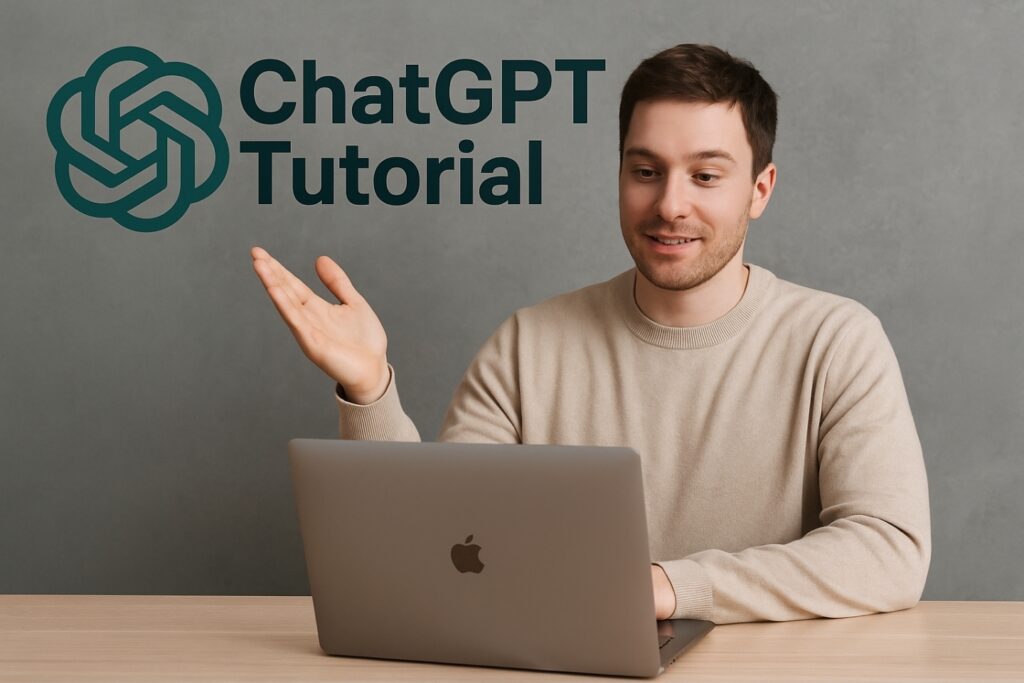Introduction:
Have you ever wished for a smart assistant who could help you write better, learn faster, and get more done? Meet ChatGPT, an advanced AI writing tool created by OpenAI. Whether you’re a student, teacher, writer, developer, entrepreneur, or just someone curious about artificial intelligence, this beginner-friendly ChatGPT tutorial will show you how to use it effectively.
In this guide, you’ll learn:
- What ChatGPT is and how it works
- How to use ChatGPT for various tasks like writing, coding, learning, and brainstorming
- Real examples and step-by-step instructions
- Pro tips for getting the best results
Let’s get started
What Is ChatGPT?
ChatGPT is a chatbot powered by artificial intelligence (AI), developed by OpenAI. It’s designed to understand your questions or instructions (called prompts) and respond in human-like text. Think of it as your friendly virtual assistant that can write, summarize, translate, generate ideas, answer questions, and even code!
It uses a machine learning model called GPT (Generative Pre-trained Transformer), trained on vast amounts of data from books, websites, and conversations. It doesn’t know everything, but it’s incredibly smart — and it’s improving every day.
How Does ChatGPT Work?
ChatGPT works by analyzing your input and predicting what text should come next. It doesn’t search the internet in real time (unless connected to a browser or plugin) — it generates answers based on what it has learned during training.
Here’s a simplified explanation:
- You type a prompt (e.g., “Write a blog post on climate change.”)
- ChatGPT analyzes your request using AI and context understanding.
- It responds with relevant content in seconds.
The more detailed and clear your prompt is, the better the response will be.
What Can You Use ChatGPT For?
Here are some powerful ways beginners are using ChatGPT:
1. Writing and Content Creation
- Blog posts: “Write a 500-word blog on digital detox.”
- Social media content: “Create 5 Instagram captions for a fitness brand.”
- Emails: “Write a professional email requesting a meeting.”
✅ Tip: Add tone and style to your prompt for better results.
👉 Example: “Write a friendly and professional welcome email for new newsletter subscribers.”
2. Brainstorming Ideas
- Business ideas: “Give me 10 low-cost startup ideas in 2025.”
- Book titles: “Suggest 5 catchy titles for a self-help book.”
- Creative stories: “Help me brainstorm a fantasy story with a dragon and a village girl.”
✅ Tip: If the results aren’t quite right, click “Regenerate” or tweak your prompt.
3. Coding Help
- Write code snippets: “Write a Python function to sort a list.”
- Explain code: “What does this JavaScript code do?”
- Debugging: “Fix this error in my code…”
✅ Example:
Prompt: “Generate an HTML page with a responsive navbar and contact form.”
ChatGPT responds with ready-to-use code — perfect for students and developers!
4. Learning and Study Help
- Summarize topics: “Summarize the causes of World War I.”
- Flashcards: “Create flashcards to learn 10 Spanish words.”
- Explain concepts: “Explain photosynthesis like I’m 10 years old.”
✅ Tip: Use follow-up questions to dive deeper into any topic.
5. Productivity and Time Management
- Create schedules: “Make a weekly study plan for Class 10 student.”
- Organize tasks: “List to-dos for launching a YouTube channel.”
- Meeting prep: “Create an agenda for a 30-minute client meeting.”
✅ Prompt example:
“Generate a daily routine for someone working from home with 2 kids and part-time freelancing.”
How to Use ChatGPT: Step-by-Step for Beginners
Here’s a simple walkthrough:
✅ Step 1: Sign Up
Go to https://chat.openai.com and create a free account.
✅ Step 2: Start a New Chat
Click “New Chat” and enter your prompt in the message box.
✅ Step 3: Type a Clear Prompt
Be specific. Instead of “help with email,” try:
“Write a professional email to a client apologizing for a delay in project delivery.”
✅ Step 4: Review the Response
ChatGPT will reply in seconds. Read, copy, or ask it to rewrite or expand.
✅ Step 5: Continue the Conversation
It remembers your context — ask follow-ups like “Make it more formal” or “Add a thank-you line.”
Best Practices for Using ChatGPT
- Be specific and detailed. More context = better answers.
- Use follow-up prompts. It learns as you go.
- Double-check facts. It may not always be accurate.
- Give feedback. Say “Make it shorter” or “Add humor.”
- Stay safe. Don’t share personal or sensitive information.
SEO Keywords You Should Know
If you’re creating content with ChatGPT, add keywords like:
- “How to use ChatGPT”
- “ChatGPT tutorial for beginners”
- “AI writing tool for students”
- “ChatGPT for productivity”
- “ChatGPT for content creation”
These help your blog or videos rank on search engines!
Final Thoughts: Why You Should Try ChatGPT Today
ChatGPT isn’t just a chatbot — it’s a creativity booster, study buddy, writing assistant, and productivity partner all rolled into one. Whether you’re stuck on a school assignment, building your next blog, starting a new business, or just curious about AI, this powerful tool is ready to help.
So what are you waiting for?
Sign up, start typing, and unlock the future of AI today!
If you found this ChatGPT tutorial helpful, share it with friends and subscribe for more AI tips and tricks.

